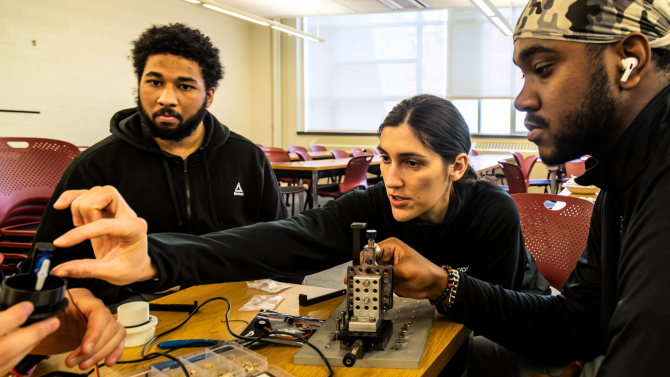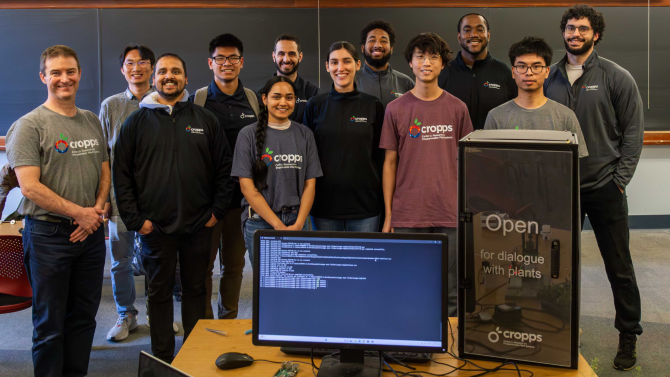During Cornell's spring break in April, a group of students did something unusual: they helped a plant send a text message.
"Hi, I'm hurt! Please help!"
The call for help was interpreted or 'heard' by the student's proof-of-concept device, using a microscope to observe Arabidopsis thaliana, a small flowering plant widely used as a model organism in plant biology. When physically stressed, the plant released optical signals that were picked up by a microscope, interpreted by a computer and converted into the message.
Students in engineering, computer science and plant biology collaborated to build a working prototype that could detect when a plant is in distress.
This work was part of the "CROPPS-in-a-Box" hackathon - an intensive, weeklong event hosted by the Center for Research on Programmable Plant Systems (CROPPS) - students in engineering, computer science and plant biology collaborated to build a working prototype that could detect when a plant is in distress.
While the prototype used the Arabidopsis plant - favored in laboratories for its simple genome and short life cycle - the implications extend far beyond. The principles demonstrated here hold promise for future systems that allow crops to communicate directly with growers about environmental stressors like drought, nitrogen deficiencies or pests.
It marks the first plant-generated text message as a result of a programmed response, rather than a reaction triggered by the plant's native biological processes.
The entire system was housed in a custom-built box that gave the CROPPS-in-a-Box hackathon its name. Approximately four feet tall and two feet wide and deep and equipped with a light-sealed door to control conditions inside, the box, built during the week, provided a controlled environment where sensors, cameras and microscopes could observe the plant without outside interference.
On the door, a simple invitation was written: "Open for a dialogue with plants." It became a guiding metaphor for the week, as students worked to give plants a voice - and humans a way to listen.
The breakthrough - a system that detects a natural gene-encoded stress response in a plant to trigger a text message - marked a striking milestone for the CROPPS team. The prototype offers a compelling demonstration of programmable plants in action and will be used in future research and collaborations on the science of responsive plant systems.
The team successfully demonstrated the CROPPS-in-a-Box during the Expanding Your Horizons (EYH) conference at Cornell on April 5, where middle and high school students interacted with the system and explored how plants can communicate through programmable systems. The prototype developed during the hackathon gave EYH students a chance to turn plant biology into a real-time, programmable communication platform.
"This was a moment that felt both whimsical and historic," said Vesna Bacheva, a CROPPS postdoctoral associate and Schmidt Science Fellow who advised the hackathon participants. "It's playful on the surface, but behind it is a real step toward building systems for plant-to-human communication."
The hackathon builds directly on years of research by CROPPS scientists, including a new study published April 23 in Proceedings of the National Academy of Sciences. That paper, led by Bacheva, solves a century-old mystery by revealing how changes in pressure inside a plant's vasculature help transmit chemical and mechanical signals in response to stress.
While the journal article lays out the theory, the hackathon brought that theory to life.
"The CROPPS-in-a-Box development was an opportunity for computer science and engineers to engage with the unique challenges of creating an Internet of Living Things, connecting plants, people and the cloud," said Abe Stroock '95, the Gordon L. Dibble '50 Professor of Chemical and Biomolecular Engineering in Cornell Engineering and director of CROPPS.
Based on more than three years of science focused on programming a plant to have a readable response, the interdisciplinary sprint challenged students to bridge fundamental plant science with hardware, software and systems thinking. Working in teams, they developed code, fabricated components and integrated sensors - culminating in a functioning prototype that made visible and translatable what was once invisible and abstract.
To simulate stress in the current prototype, a participant manually injured one of the plant's leaves and then closed the door to begin signal detection. To support future studies, a team of mechanical engineering students designed an early-stage mechanism that automates this step. Their programmable cutting device is capable of remotely wounding a leaf inside the box, enabling more controlled, repeatable tests and allowing stress events to be triggered without disrupting the sensor environment.
The Hackathon team included undergraduate students Zeke Jeremiah Evans '25, Braddy Maria '28 and Gabriel Leung '27; masters in engineering students Yashaswini Mandalam and Ziad Khalid Mosalam; computer science Ph.D. student Salman Abid; engineering Ph.D. student Eric Wu; and CROPPS trainees Vesna Bacheva, Muzhi Jiang, Israel Gabay, Anand Mishra and Khoi Ly
"The energy was incredible," Bacheva said. "These students brought fresh ideas and a willingness to tinker, refine, and complete a working prototype. They weren't just learning from us - they were helping us imagine new directions for the emerging field of programmable plant systems."
As CROPPS continues to explore how plants can be made more communicative, events like CROPPS-in-a-Box offer a glimpse of what's possible when biology, engineering and computer science converge.
"We're not just solving scientific puzzles - we're reimagining what agriculture could be," Stroock said. "And sometimes that starts with a plant sending a text that says, 'Help.'"
Related:
Century-old mystery of plant communication solved: In a companion study also from CROPPS, researchers uncover how pressure changes inside plants transmit signals during stress - offering a mechanistic foundation for plant-to-human communication systems.








